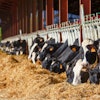
Upward soybean, corn prices are expected to continue as fields dry and exports surge
An unexpected turn in Midwestern U.S. weather has canceled projections of record-breaking crop yields and has prices for corn and soybeans creeping upward — a trend that may continue for some time.
Soybean futures hit two-year highs after the U.S. Department of Agriculture (USDA) cut projected yields by 1 million tons in the September World Markets and Trade report. USDA anticipates the average on-farm price for soybeans harvested this season could reach US$9.25 per bushel, nearly a dollar higher than the U.S. agency expected when it released its August report. Projected corn prices have also increased 40 cents to US$3.50 per bushel, according to the USDA.
September marked the first report since the August derecho swept across the Midwest, much of which has also experienced two months of dry weather, according to Mac Marshall, vice president of market intelligence for the United Soybean Board. Iowa in particular has experienced especially dry weather, reducing corn yields in that critical state, Paul Bertels, a principal economist at Farmgate Insights, said.
“You have a little over a seventh of the corn crop in Iowa, so when you have a state like Iowa showing some pretty significant dryness across the state, that number is going to come down,” Bertels said.
Then the derecho hit on August 10. USDA quickly indicated that some revised yield numbers could be in order, but decided to wait until September to issue the verdict. Now, Bertels said, “there is clearly a half million acres of corn in Iowa that was destroyed and probably won’t be harvested.”
Soybeans also sustained damage, Marshall said but, overall, the soy crop still looks strong. On top of the decreased crop production, export activity for soybeans has seen a rapid uptick, fueled by growing demand from China.
“In my estimation, that’s really the biggest driver here,” Marshall said. “Certainly the reduction matters, but it will still be the second or third largest crop on record.”
Part of this is thanks to the Phase 1 trade deal between the U.S. and China, Marshall said, but a large portion of the the increase can also be attributed to China’s recovery from African swine fever (ASF).
“Reports are that they are bringing hog production back more quickly than some estimated that they could,” Bertels said.
On top of this, Bertels said, some reports indicate that China has experienced food and feed price inflation, prompting the Chinese government to increase imports of pork and corn. Corn imports in particular have increased, which Bertels said indicates the Chinese government may be in the process of rotating out its grain reserves.
“In China, that information is considered a state secret,” he said. “What we do know through stories in the press over there and firsthand accounts is that China over the last couple of years has tried to draw down the amount of corn they had in state reserves. There has also been some anecdotal information that a lot of that corn sitting in state reserves is of horrible quality.”
That being the case, Bertels said the uptick in corn imports is likely temporary and will return to status quo when the pork industry and reserves have stabilized.
Soybeans, on the other hand, may still have room for increased demand, Marshall said.
“Right now, total demand is still below where we were pre-ASF,” he said. “The Chinese government has stated the goal is to return to that, before the end of the calendar year. So we’re not there yet — there’s probably some demand growth to come yet.”

















